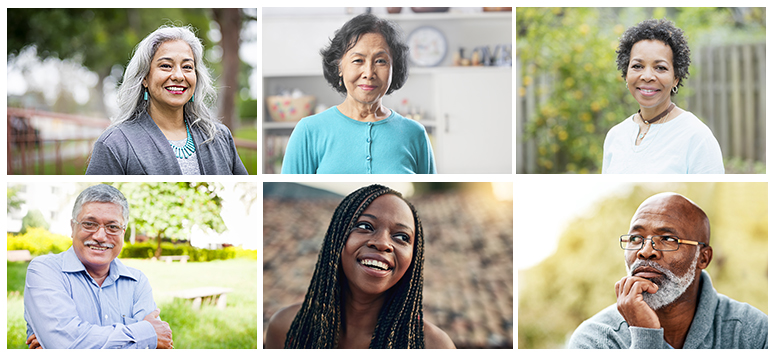People with darker skin tones can get rosacea
Rosacea is a common condition that affects the skin on the face and sometimes the eyes. It often begins with a tendency to flush or blush easily. With time, that warm feeling on the face tends to last longer and may eventually become constant.
Studies show that when people with darker skin tones develop rosacea, the early signs, such as flushing, can be missed or mistaken for another condition.
Without treatment, rosacea can worsen. Your face may burn and sting every time water touches it or you apply a skin care product. Some people develop acne-like breakouts. When rosacea affects the eyes, it can cause problems with your eyesight.
Even when it worsens, rosacea can be missed in people who have darker skin tones.

Signs of rosacea in darker skin tones
If you have a darker skin tone, dermatologists recommend that you make a dermatology appointment if you notice any of the following on your face:
A warm feeling most of the time
Dry, swollen skin and patches of darker skin
A dusky brown discoloration to your skin
Acne-like breakouts that acne treatment won’t clear
Yellowish-brown, hard bumps around your mouth, eyes, or both
Burning or stinging when you apply skin care products
Swelling and thickening skin on your nose, cheeks, chin, or forehead
Signs that rosacea is affecting your eyes
When rosacea affects the eyes, it’s called ocular rosacea. Here are signs that rosacea may be affecting your eyes:
Swollen, warm eyelids
Red, bloodshot eyes
Pink eye (also known as conjunctivitis)
Crusty eyelids or eyelashes
Tearing (or dry eyes)
A feeling you have something in your eye
Burning and stinging in your eyes
Itchy, irritated eyes
Sensitivity to light
Even when the rosacea on your skin is mild, you can develop eye problems. If you have any of these signs or symptoms, see a board-certified dermatologist or ophthalmologist.
Without treatment, ocular rosacea can affect your eyesight.
Another sign of rosacea: It worsens with certain activities
If you have rosacea, you may notice that it worsens at certain times of the year or when you do certain things. In the winter, your face may feel raw and irritated when you’re outside on a cold, windy day. After drinking a glass of red wine, your face may feel hot and uncomfortable.
Anything that worsens your rosacea is called a trigger. Many things can be a trigger, and triggers tend to vary from person to person. Some of the most common rosacea triggers are:
Stress
Sunlight
Alcohol, especially red wine
Wind
Heat
Spicy foods
Hot beverages
Exercise
Some skin care or hair care products
If you notice that something irritates your skin, find out what happens when you avoid it. Does your skin feel better or look clearer?
Treatment can prevent rosacea from worsening
If you notice any of these signs or symptoms, it’s important to find out if you have rosacea. Rosacea is a chronic condition, which means you may have it for life.
Treatment can help:
Ease symptoms, so you feel more comfortable
Reduce flare-ups
Prevent rosacea from worsening and affecting your eyes
A treatment plan for rosacea usually involves being gentle with your skin, using rosacea friendly skin care products, applying medication to your skin, and avoiding your triggers.
Why see a board-certified dermatologist?
In darker skin tones, rosacea can look like many other conditions, including acne, seborrheic dermatitis, an allergic reaction, or lupus. Dermatologists receive more training in diagnosing and treating conditions that affect the skin than other doctors.
Related AAD resources
Images
Getty Images
References
Al-Dabagh A, Davis SA, et al. “Rosacea in skin of color: not a rare diagnosis.” Dermatol Online J. 2014;20(10).
Alexis AF, Callender VD, MD, et al. “Global Epidemiology and Clinical Spectrum of Rosacea, Highlighting Skin of Color: Review and Clinical Practice Experience.” J Am Acad of Dermatol. 2018: doi: https:// doi.org/10.1016/j.jaad.2018.08.049.
Callendar VD, Barbosa V, et al. “Approach to treatment of medical and cosmetic facial concerns in skin of color patients.” Cutis. 2017;100(6):375-80.
Last updated: 1/11/23
 Atopic dermatitis: More FDA-approved treatments
Atopic dermatitis: More FDA-approved treatments
 Biosimilars: 14 FAQs
Biosimilars: 14 FAQs
 How to trim your nails
How to trim your nails
 Relieve uncontrollably itchy skin
Relieve uncontrollably itchy skin
 Fade dark spots
Fade dark spots
 Untreatable razor bumps or acne?
Untreatable razor bumps or acne?
 Tattoo removal
Tattoo removal
 Scar treatment
Scar treatment
 Free materials to help raise skin cancer awareness
Free materials to help raise skin cancer awareness
 Dermatologist-approved lesson plans, activities you can use
Dermatologist-approved lesson plans, activities you can use
 Find a Dermatologist
Find a Dermatologist
 What is a dermatologist?
What is a dermatologist?